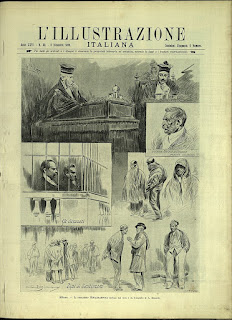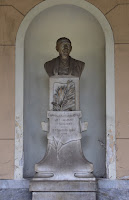NEW - Emanuele Notarbartolo - banker and politician
First major figure to be assassinated by Mafia
The banker and politician Emanuele Notarbartolo, whose determination to end corrupt banking practices in Sicily in the late 19th century would cost him his life, was born on this day in 1834 in Palermo. Notarbartolo served as a conservative Mayor of Palermo from 1873 to 1876 and director of the Banco di Sicilia from 1876 to 1890. He saved the bank from going bust by stamping down on the practice of doling out large and effectively unsecured loans to favoured individuals but in doing so made many enemies. Having survived being kidnapped in 1882, Notarbartolo was stabbed to death in his first-class compartment on a train just outside Palermo, his body thrown out of the carriage on to the track side. Although ultimately they were set free as the legal process broke down, Raffaele Palizzolo, a rival politician with Mafia connections as well as a fellow member of the Banco di Sicilia board, and a boss of the Villabate mafia clan, Giuseppe Fontana, were identified as being responsible for his death. Each was sentenced to 30 years in prison. Murders involving members of the Cosa Nostra were commonplace but the victims were generally other mafiosi or associates. Read more…
________________________________________
John Keats – poet
Writer spent his final days in the Eternal City
English Romantic poet John Keats died on this day in Rome in 1821. He had been a published writer for five years and had written some of his greatest work before leaving England. Ode to a Nightingale, one of his most famous poems, was written in the spring of 1819 while he was sitting under a plum tree in an English garden. Keats was just starting to be appreciated by the literary critics when tuberculosis took hold of him and he was advised by doctors to move to a warmer climate. He arrived in Rome with his friend, Joseph Severn, in November 1820 after a long, gruelling journey. Another friend had found them rooms in a house in Piazza di Spagna in the centre of Rome and they went past the Colosseum as they made their way there. Keats slept in a room overlooking the Piazza and could hear the sound of the fountain outside, which may have inspired the words he later asked to be put on his tombstone. To begin with he was well enough to go for walks along the Via del Corso and he enjoyed sitting on the Spanish Steps, but he was advised by his doctor against visiting the city’s main attractions. Read more…
_____________________________________
Corrado Cagli - painter
Jewish artist who fought in World War II as a US soldier
The painter Corrado Cagli, one of the outstanding figures in the New Roman school that emerged in the early part of the 20th century, was born in Ancona on this day in 1910. He moved with his family to Rome in 1915 at the age of five and by the age of 17 had created his first significant work, a mural painted on a building in Via Sistina, the street that links Piazza Barberini with the Spanish Steps in the historic centre of the city. The following year he painted another mural inside a palazzo on the Via del Vantaggio, not far from Piazza del Popolo. In 1932, he held his first personal exhibition at Rome’s Galleria d’Arte Moderna. At this stage, despite being both Jewish and gay, Cagli had the support of the Fascist government, who commissioned him and others to produce mosaics and murals for public buildings. Although he would go on to experiment in Neo-Cubist style and metaphysical styles, the aim of the Scuola Romana he sought to establish with fellow artists such as Giuseppe Capogrossi and Emanuele Cavalli was to reaffirm the principles of classical and Renaissance art. Read more...
______________________________________
Giovanni Battista de Rossi - archaeologist
Excavations unearthed massive Catacomb of St Callixtus
Giovanni Battista de Rossi, the archaeologist who revealed the whereabouts of lost Christian catacombs beneath Rome, was born on this day in 1822 in the Italian capital. De Rossi’s most famous discovery – or rediscovery, to be accurate – of the Catacomb of St Callixtus, thought to have been created in the 2nd century by the future Pope Callixtus I, at that time a deacon of Rome, under the direction of Pope Zephyrinus, established him as the greatest archaeologist of the 19th century. The vast underground cemetery, located beneath the Appian Way about 7km (4.3 miles) south of the centre of Rome, is estimated to have covered an area of 15 hectares on five levels, with around 20km (12.5 miles) of passageways. It may have contained up to half a million corpses, including those of 16 popes and 50 Christian martyrs, from Pope Anicetus, who died in 166, to Damasus I, who was pontiff until 384. Nine of the popes were buried in a papal crypt. The complex steadily fell into disuse thereafter and the most important relics were removed over the centuries and relocated to churches around Rome. Read more…
____________________________________
Gentile Bellini - Renaissance painter
Bellini family were Venice's leading 15th century artists
Gentile Bellini, a member of Venice's leading family of painters in the 15th century, died in Venice on this day in 1507. He was believed to be in his late 70s, although the exact date of his birth was not recorded. The son of Jacopo Bellini, who had been a pioneer in the use of oil paint in art, he was the brother of Giovanni Bellini and the brother-in-law of Andrea Mantegna. Together, they were the founding family of the Venetian school of Renaissance art. Although history tends to place Gentile in their shadow, he was considered in his time to be one of the greatest living painters in Venice and from 1454 he was the official portrait artist for the Doges of Venice. He also served Venice as a cultural ambassador in Constantinople, where he was sent to work for Sultan Mehmed II as part of a peace settlement between Venice and Turkey. Gentile learned painting in his father's studio. Once established, he had no shortage of commissions, for portraits, views of the city, and for large paintings for public buildings, often characterised by multiple figures. He was one of the artists hired by the Scuola Grande di San Giovanni Evangelista to paint a 10-painting cycle known as The Miracle of the Relics of the Cross. Read more…
.jpg)



.jpg)







.jpg)
.jpg)


.jpg)

